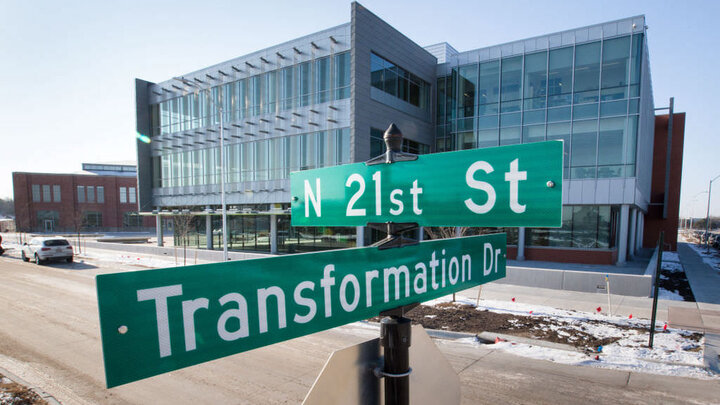Nebraska Innovation Campus ahead of its timetable for completion

By Natasha Rausch / World-Herald bureau
LINCOLN — The former State Fair Park is gone. In its place sits three state-of-the-art buildings that mark a new era of engineering and science at the Nebraska Innovation Campus, where private and public sectors will combine to create new technology near the Bob Devaney Sports Center. Construction began in 2013, and now the campus has 380,000 of the 2.2 million square feet covered, with $120 million spent.
Executive Director Dan Duncan said the goal is to have the project completed by 2038.
“We’re ahead of plan right now,” he said.
So far, the former 4-H building has been reconstructed to become part of the Innovation Commons, where a conference center with a 400-seat auditorium is located. Additonal conference center facilities include a banquet room and eight breakout rooms. A grand opening for the center was in August.
Two other buildings that are almost completed are the Greenhouse Innovation Center and the Food Innovation Center, scheduled to open in April and July, respectively.
Duncan said that to stay on track, 80,000 square feet of buildings must be added each year. Approximately 23 more buildings will be built on the remaining 1.82 million square feet of available land.
“Our focus is on getting the construction that is underway completed and filled,” Duncan said. “There will be another grand opening this fall for the whole campus.”
The state provided $25 million of the $120 million in construction costs. Tetrad Property Group in Omaha provided most of the rest.
Duncan said the millions of dollars’ worth of buildings is creating construction jobs.
As the buildings are completed, private and public sectors are beginning to use the space.
This fall, University of Nebraska- Lincoln professor Shane Farritor and maker space coordinator Liana Owad will teach the first class on the new campus: Making for Innovation.
Duncan said Farritor needed to see if UNL students were interested in the topic before a class could be held.
“When Dr. Farritor first surfaced the idea of an innovation studio, he started a maker club to test it out. It has 750 members,” Duncan said.
The class filled quickly, and Duncan said this is just the first of many classes on the new campus.
Although public sector entities are using most of the space now, ConAgra is the first private sector entity to collaborate with the university. It will move into the Food Innovation Center along with the university’s Food Science Department when the building opens.
A campus goal is to have 5,000 employees — one-third from the public sector and the rest from the private sector.
Currently there are about 70 employees, of which two-thirds are from the university.
Duncan said that by August, employment should be up to 400 or 500, and more entities from the private sector will begin moving in as planned.
As additonal businesses move in and more buildings go up, energy efficiency on the campus will increase. The campus is powered by Lincoln’s waste water, which eventually will reduce heating and cooling costs by 30 percent.
Duncan said the system is “operating above specs” because the flow rate is 150,000 gallons per minute, and right now, the campus uses only 50 gallons per minute.
The campus has yet to see the heating and cooling system work at full capacity.
A grand opening is planned for the fall, when construction will begin on one or two more buildings. Duncan said the grand opening will begin an era of innovation in Nebraska.
“Part of what we want to do is help create a corpus of people who want to innovate,” Duncan said. “Innovation campus is about creating a sustaining culture. We’ve started that. We’re helping to shape interesting thinking.”
